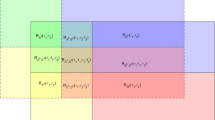Abstract
We propose a method that allows opportunistic shared channel utilization in multi-user multiple-input multiple-output systems, without causing any interference towards the primary system. It is shown that with appropriate exploitation of demodulation pilot signaling, the opportunistic system can quantify all the necessary information in order to guarantee complete interference mitigation towards the primary system. Opportunistic signal space utilization is based on the assumption of reciprocal zero-forcing transmitter and receiver design in the primary system and use of time division duplexing. Linear beamforming is coupled with greedy scheduling for efficient exploitation of multi-user diversity in both the primary system and the cognitive systems.








Similar content being viewed by others
References
Amir, M., El-Keyi, A., & Nafie, M. (2010). Opportunistic interference alignment for multiuser cognitive radio. In Proceedings of the IEEE information theory workshop (pp. 1–5).
Bengtsson, M., & Ottersten, B. (2001). Optimal and suboptimal transmit beamforming. In L. C. Godara (Ed.), Handbook of antennas in wireless communications. Boca Raton, FL: CRC Press.
Cadambe, V. R., & Jafar, S. A. (2008). Interference alignment and degrees of freedom of the \(k\)-user interference channel. IEEE Transactions on Information Theory, 54(8), 3425–3441.
Du, H., Ratnarajah, T., Pesavento, M., & Papadias, C. (2012). Joint transceiver beamforming in MIMO cognitive radio network via second-order cone programming. IEEE Transactions on Signal Processing, 60(2), 781–792.
Gesbert, D., Hanly, S., Huang, H., Shitz, S. S., Simeone, O., & Yu, W. (2010). Multi-cell MIMO cooperative networks: A new look at interference. IEEE Journal on Selected Areas in Communications, 28(9), 1380–1408.
Goldsmith, A., Jafar, S. A., Maric, I., & Srinivasa, S. (2009). Breaking spectrum gridlock with cognitive radios: An information theoretic perspective. Proceedings of the IEEE, 97(5), 894–914.
Jafar, S. A., & Fakhereddin, M. J. (2007). Degrees of freedom for the MIMO interference channel. IEEE Transactions on Information Theory, 53(7), 2637–2642.
Jung, B. C., & Shin, W. Y. (2011). Opportunistic interference alignment for interference-limited cellular TDD uplink. IEEE Communications Letters, 15(2), 148–150.
Komulainen, P., Tölli, A., Latva-aho, M., & Juntti, M. (2009). Downlink assisted uplink zero forcing for TDD multiuser MIMO systems. EURASIP Journal on Wireless Communications and Networking, 2009:1–11.
Komulainen, P., Tölli, A., & Juntti, M. (2010). CSI signaling for decentralized coordinated beamforming in TDD multi-cell MIMO systems. In Proceedings of the Annual Asilomar Conference on Signals, Systems and Computers.
Mitola, J., & Maguire, J. G. (1999). Cognitive radio: Making software radios more personal. IEEE Personal Communications Magazine, 6(4), 13–18.
Negro, F., Ghauri, I., & Slock, D. T. M. (2009). Transmission techniques and channel estimation for spatial interweave TDD cognitive radio systems . In Proceedings of the annual Asilomar conference on signals, systems and computers (pp. 523–527).
Negro, F., Ghauri, I., & Slock, D. (2010). Beamforming for the underlay cognitive MISO interference channel via ul-dl duality. In: 2010 Proceedings of the fifth international conference on cognitive radio oriented wireless networks communications (CROWNCOM) (pp 1–5).
Peel, C. B., Hochwald, B. M., & Swindlehurst, A. L. (2005). A vector-perturbation technique for near-capacity multiantenna multiuser communication-part I: Channel inversion and regularization. IEEE Transactions on Communications, 53(1), 195–202.
Perlaza, S., Fawaz, N., Lasaulce, S., & Debbah, M. (2010). From spectrum pooling to space pooling: Opportunistic interference alignment in MIMO cognitive networks. IEEE Transactions on Signal Processing, 58(7), 3728–3741.
Schubert, M., & Boche, H. (2004). Solution of the multiuser downlink beamforming problem with individual SINR constraints. IEEE Transactions on Vehicular Technology, 53(1), 18–28.
Shen, C., & Fitz, M. (2011). Opportunistic spatial orthogonalization and its application in fading cognitive radio networks. IEEE Journal of Selected Topics in Signal Processing, 5(1), 182–189.
Shi, S., Schubert, M., & Boche, H. (2008) Per-antenna power constrained rate optimization for multiuser MIMO systems. In International ITG workshop on smart antennas, 2008. WSA 2008 (pp 270–277).
Shi, S., Schubert, M., & Boche, H. (2008). Rate optimization for multiuser mimo systems with linear processing. IEEE Transactions on Signal Processing, 56(8), 4020–4030.
Suh, C., & Tse, D. (2008). Interference alignment for cellular networks. In Proceedings of the annual allerton conference on communications, control, and computing (pp. 1037–1044).
Tajer, A., Prasad, N., & Wang, X. (2010). Beamforming and rate allocation in MISO cognitive radio networks. IEEE Transactions on Signal Processing, 58(1), 362–377.
Tölli, A., Codreanu, M., & Juntti, M. (2008). Cooperative MIMO-OFDM cellular system with soft handover between distributed base station antennas. IEEE Transactions on Wireless Communications, 7(4), 1428–1440.
Tölli, A., Pennanen, H., & Komulainen, P. (2011). Decentralized minimum power multi-cell beamforming with limited backhaul signaling. IEEE Transactions on Wireless Communications, 10(2), 570–580.
Visotsky, E., & Madhow, U. (1999). Optimum beamforming using transmit antenna arrays. In Proceedings of the IEEE vehicular technology conference (Vol, 1, pp. 851–856). Houston, TX.
Wiesel, A., Eldar, Y. C., & Shamai, S. (2006). Linear precoding via conic optimization for fixed MIMO receivers. IEEE Transactions on Signal Processing, 54(1), 161–176.
Acknowledgments
This work has been supported by the Finnish Funding Agency for Technology and Innovation (Tekes), Elektrobit, Nokia, Nokia Siemens Networks (NSN), Uninord, Xilinx and Renesas Mobile Europe.
Author information
Authors and Affiliations
Corresponding author
Rights and permissions
About this article
Cite this article
Kaleva, J., Komulainen, P., Juntti, M. et al. Zero-Forcing Spatial Interweave with Greedy Scheduling. Wireless Pers Commun 72, 1649–1662 (2013). https://doi.org/10.1007/s11277-013-1126-8
Published:
Issue Date:
DOI: https://doi.org/10.1007/s11277-013-1126-8




